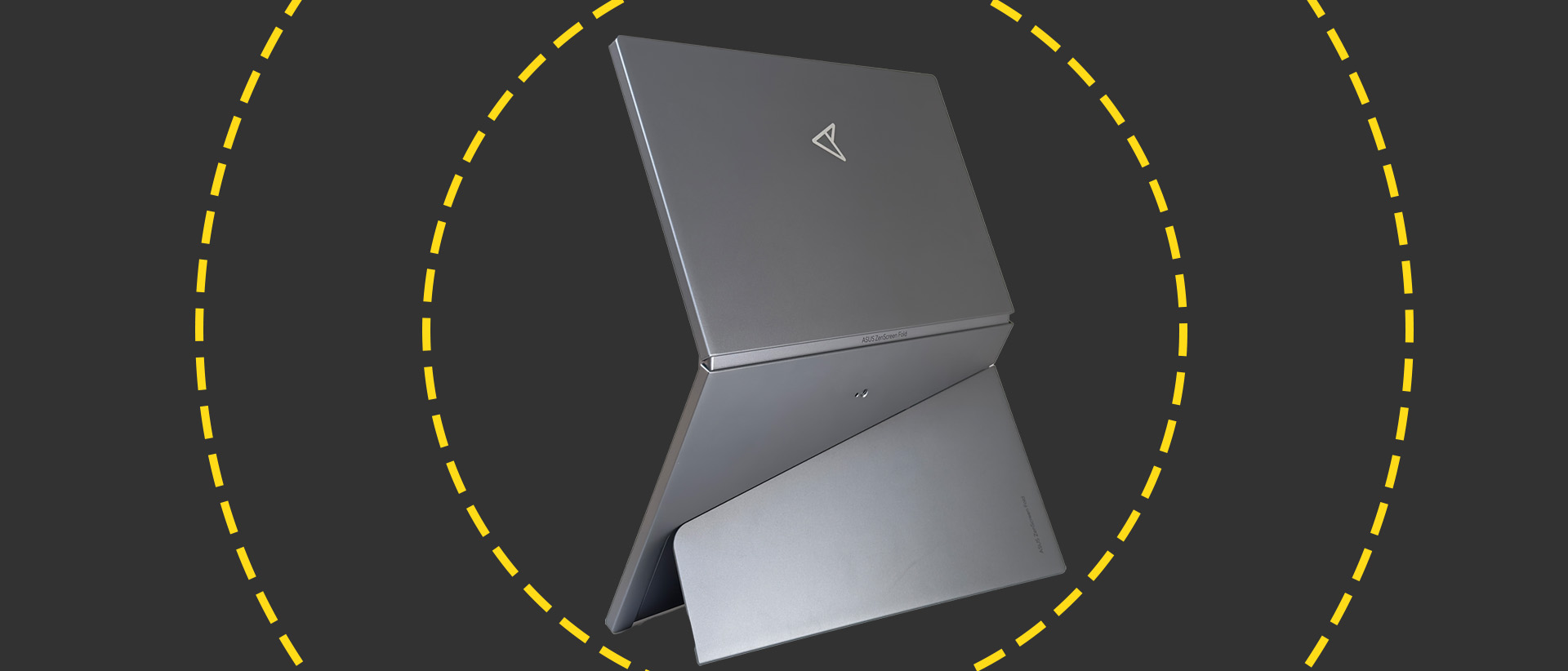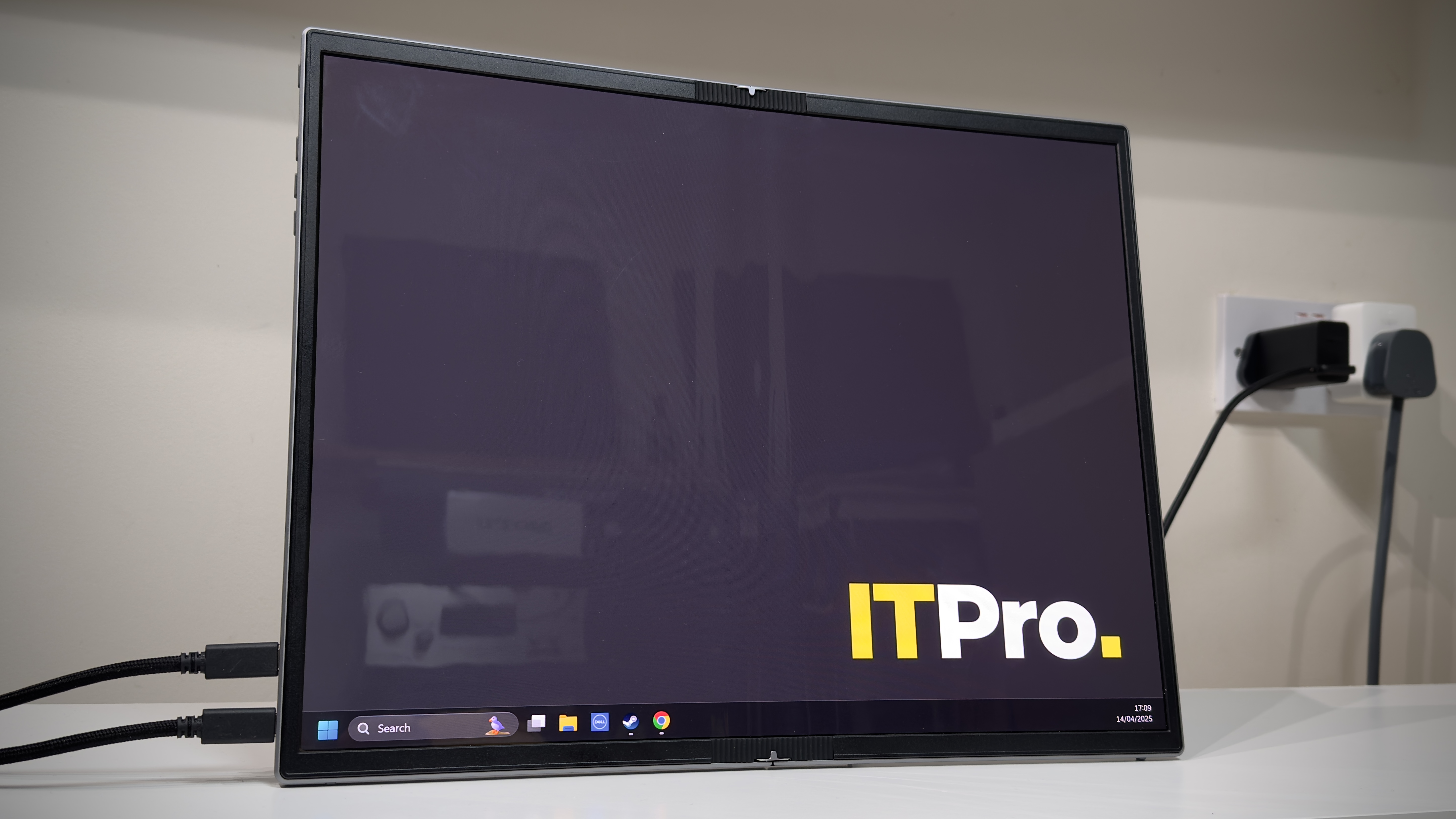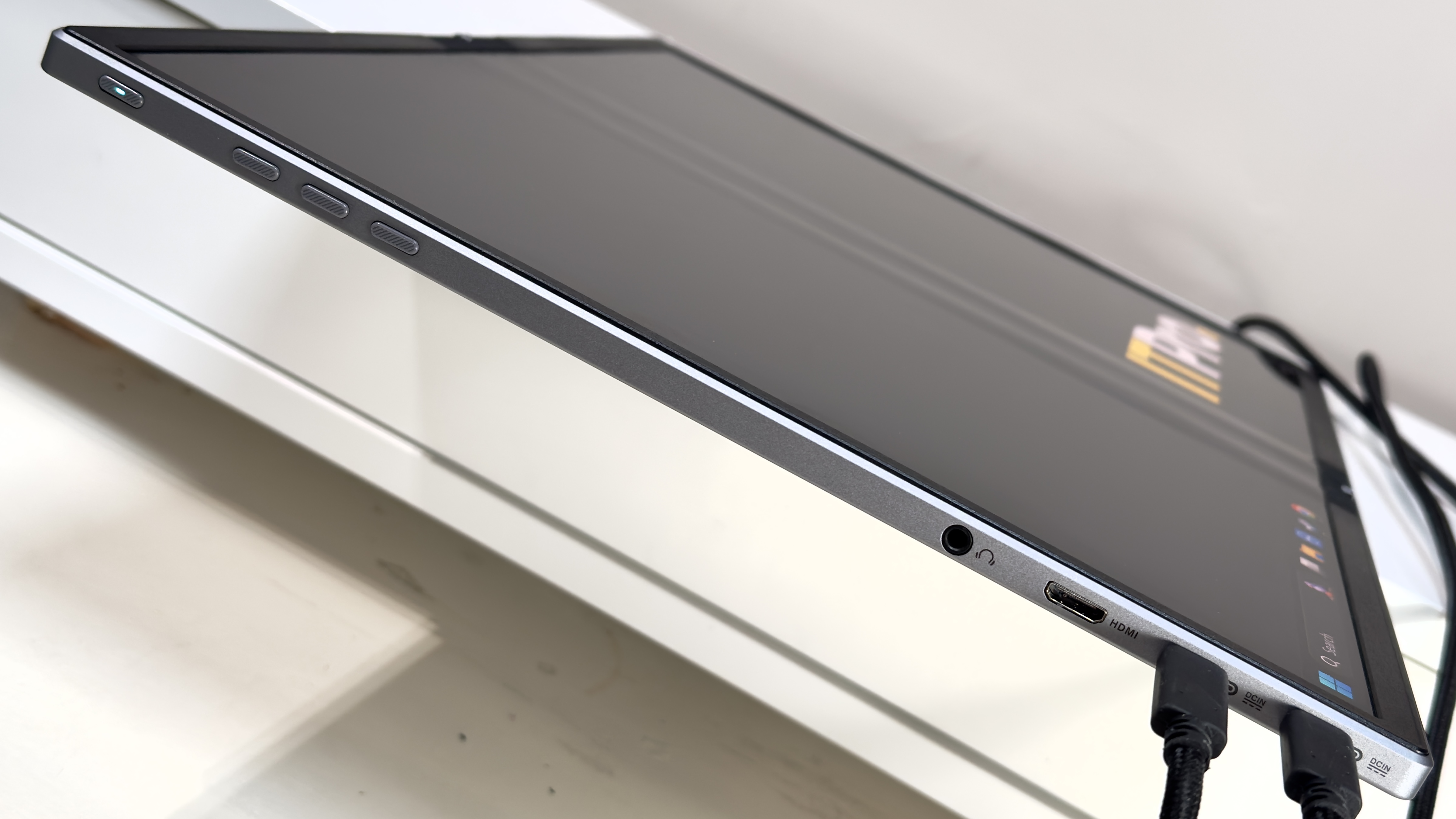Asus ZenScreen Fold OLED MQ17QH review: The portable monitor your small business can't afford
A stunning foldable 17.3in OLED display – but it's too expensive to be anything more than a thrilling tech demo

-
+
Image quality is great in SDR and HDR
-
+
Very compact for a 17-inch monitor
-
+
Can be used in both portrait and landscape
-
-
Outrageously expensive
-
-
sRGB mode is broken
-
-
Screen ripples can be distracting

If you've often dreamed of carting your multi-monitor setup to the local coffee shop, then portable models have turned that from a pipedream to a possibility. If, however, you demand nothing less than pristine OLED perfection whilst on your travels, then Asus has answered your prayers: the ZenScreen Fold OLED MQ17QH packs a 17.3-inch folding OLED panel into a smaller footprint than your laptop.
Asus ZenScreen Fold OLED MQ17QH: Design & Features
Yes, you read that right: folding. This is a 17.3-inch, 2,560 x 1,920 OLED monitor that folds in half. As a result, you'd be forgiven for mistaking the MQ17QH for a rather chunky clamshell laptop – we certainly did. It's 20mm thick when folded, yet blessed with a surprisingly small footprint, measuring a dainty 180mm x 290mm. Weight is relatively high by portable monitor standards, though, at 1.17kg.
Connectivity includes two USB-C ports, both of which support DP Alt Mode, one mini HDMI, and a 3.5mm headphone jack. A supplied USB-C 30W wall-wart charger is accompanied by two nice-feeling braided USB-C cables, both of which have one right-angled connector and one straight. There's a full-sized HDMI to mini HDMI cable, too.
Prise open the solid-feeling aluminium clamshell and the glossy OLED panel reveals itself. The so-called "waterdrop" hinge allows the panel to curve around neatly inside, and that fold in the centre flattens out (well, mostly – but we'll moan about that later) as you open the two halves.
At the rear, a large metal flap folds out to form a kickstand. This allows you to position the monitor in either landscape (4:3) or portrait (3:4) modes. In landscape orientation, ridged rubber bumpers on the edges stop it sliding around on smoother surfaces, although there aren't any on the bottom edge when in portrait mode. An orientation sensor allows for automatic screen rotation, so Windows users will want to install the Asus DisplayWidget Center software to take advantage. Sadly, there's no Mac version.

The stand offers very little in the way of adjustability. In portrait mode, you can tilt the top half of the screen towards you a little, which does help reduce glare in some situations, but in landscape mode, it's fixed in an almost vertical position. This is fine if you can position the monitor slightly above your laptop, but it's not ideal.
Asus is clearly aware that the kick-stand won't be adjustable enough for many people, so it has added a single-threaded tripod mount to the rear panel. Attach the 1/4in thread to any standard tripod head, and you've got yourself a little (or comically large, depending on your tripod) adjustable stand. Should you prefer a more conventional (and more portable) monitor stand, then a small screw-in mount in the box allows you to connect to Asus' MTS02D stand, which provides height adjustment, tilt, and swivel. It'll relieve you of another £100 or so, though.
The four buttons on the display's edge allow you to toggle the display on and off, select from either of the three inputs, and flick through the familiar-looking Asus on-screen displays. There are no surprises here: you get eight preset image modes, most of which are fairly pointless. We'd leave the panel in Standard mode for most purposes. Activate HDR, and there are only two modes: Cinema HDR and Gaming HDR.
One important consideration is that the MQ17QH only performs to its maximum potential with its dedicated USB-C power supply. It will work with a single USB-C cable connected to a laptop, but brightness drops down to below 100cd/m2 – a dim 77cd/m2 with our Dell XPS 13 9340. If there are no mains sockets nearby, this may prove annoying. Another annoyance is that, even when the PSU is connected, it didn't charge either of our two test laptops. If you don't have two power sockets nearby, you'll need to swap the charger back to your laptop when the battery runs low.
Oddly, in some scenarios, excessive power draw saw the monitor turn off completely. For instance, with a USB-C connection to our laptop and using the mini-HDMI video input, the MQ17QH turned off and restarted itself when watching HDR content with intensely bright highlights. Clearly the power draw was too high for the wattage our laptop could supply. Again, though, this could be a bug with the brightness limiter not kicking in when it should. When we swapped back from the mini-HDMI connection to the USB-C input, the brightness limiter activated, dimming the screen and preventing the issue from occurring.
Asus ZenScreen Fold OLED MQ17QH: Display quality

The specifications are impressive. Asus claims a 100% coverage of DCI-P3 and a typical screen brightness of 350cd/m2 in SDR. The VESA DisplayHDR 500 True Black certification means that you can expect over 500cd/m2 in HDR mode. Contrast is a claimed 1,000,000:1 – as close to perfect as you could ask for, in other words – and the response time is a near-instantaneous 0.2ms.
In our tests, the MQ17QH delivered on all of those claims. Color coverage is exemplary, with a 100% coverage of sRGB and DCI-P3, and an impressive 90.3% coverage of Adobe RGB. Our colorimeter rated the contrast as being infinite, and the brightness peaked at 423cd/m2 in SDR and 526cd/m2 in HDR.
Color accuracy is a little harder to judge. Firstly, the sRGB mode doesn't seem to actually do anything – we enabled it, and the color response didn't change at all. Measurements backed this up, too, with the sRGB mode achieving a higher accuracy when tested against a DCI-P3 target than sRGB. Given that this looks like an early sample – one that's clearly done the rounds going by the scuffs on the display panel – it's possible that firmware updates may remedy the issue.
For SDR usage, the most accurate mode for DCI-P3 is the Standard mode. In this mode, we measured an average Delta E of 1.46, which is very respectable. The maximum Delta E of 4.23 was less impressive, but we have our suspicions that this may be a measurement error due to the spectral properties of the folding OLED panel. Our DisplayCAL software is too old to have correction matrices for this new breed of OLED panels. Subjectively, images looked accurate to the naked eye, with rich, believable colours and lifelike skintones.
HDR performance is genuinely eye-popping. The combination of OLED's per-pixel illumination, infinite contrast, and a respectable, if not dazzling, peak brightness makes HDR content look amazingly punchy and impactful. The 4:3 screen ratio means that gaming feels a little cramped, but you get used to it, and the only disappointment with movies is that half the screen is taken up by black letterbox bars.
There are no complaints with motion clarity here. Despite the 60Hz refresh rate, the OLED panel keeps moving objects looking crystal clear. Gaming may prove a little odd on a 4:3 ratio screen, granted, but you won't have any complaints about response time.
There are some negatives. One practical issue is that the panel is very, very glossy – to the point of being mirror-like. It still does a surprisingly good job of combatting glare – point a bright light at it and there's no glare at all, just a perfect, dimmed reflection of the light source – but it is a bit distracting looking at your own reflection. The other side effect of the glossy finish is that it draws attention to the ripples in the folding section of the display. Here, the wavy, distorted reflections highlight the not-quite-flat centre – it's not maddeningly annoying, but at the price, we suspect it may bother some users.

Asus ZenScreen Fold OLED MQ17QH monitor: Is it worth it?
This is where the MQ17QH takes a violent handbrake turn into la-la land. There's no argument that it delivers highly impressive OLED image quality in a compact package, but with an asking price of over £2,000, it's not good value in any sense. Even the three years of full warranty and burn-in coverage feels like the bare minimum you should expect given the price.
As a technical demonstration, there's no doubt that the MQ17QH offers a tantalising glimpse towards the future of high-end displays, portable or otherwise. Back in the present, though, it's just not a practical choice for 99% of users, and given the various quirks, it may not even appeal to that remaining 1%. As for us at ITPro? Let's be honest: a non-folding portable monitor at a tenth of the price will do just fine.
Asus ZenScreen Fold OLED MQ17QH specifications
Display | 17.3in OLED panel | Row 0 - Cell 2 |
Panel resolution | 2,560 x 1,920 | Row 1 - Cell 2 |
Refresh rate | 60Hz | Row 2 - Cell 2 |
Panel response time | 0.2ms GtG | Row 3 - Cell 2 |
Adaptive Sync Support | Yes | Row 4 - Cell 2 |
HDR Support | Yes, DisplayHDR 500 True Black | Row 5 - Cell 2 |
Ports | 2 x USB-C (DP Alt Mode), 1 x mini HDMI, 1 x 3.5mm headphone jack | Row 6 - Cell 2 |
Other features | Microfiber cloth, mini HDMI to HDMI cable, MTS02D tripod socket kit, power adapter, quick start guide, USB-C cable, warranty card, ZenScreen bag | Row 7 - Cell 2 |
Stand | Kick-stand, limited adjustment | Row 8 - Cell 2 |
Dimensions (with stand) | Folded: 180 x 290 x 21mm, Landscape: 370 x 152 x 285mm, Portrait: 287 x 99 x 354mm (WDH) | Row 9 - Cell 2 |
Weight (with stand) | 1.17kg | Row 10 - Cell 2 |
Get the ITPro daily newsletter
Sign up today and you will receive a free copy of our Future Focus 2025 report - the leading guidance on AI, cybersecurity and other IT challenges as per 700+ senior executives
Sasha is a freelance journalist who's been writing about tech and consumer products for over two decades. With a career that started at the dawn of the millennium on Computer Buyer magazine, he passed through the official Intel Centrino magazine, Mobile Computer, before rounding off his print career on PC Pro magazine where he reviewed a broad spectrum of hardware and software before eventually specializing in laptop and monitor reviews. After the best part of a decade, he defected to the desks on the other side of the office and spent many years working on Expert Reviews before finally going freelance in 2024. Nowadays, he splits his time between reviewing tech and home appliances, falling off mountain bikes and cleaning up his kids' playroom.
-
 CyberOne appoints Microsoft’s Tracey Pretorius to its advisory board
CyberOne appoints Microsoft’s Tracey Pretorius to its advisory boardNews The threat intelligence leader will provide strategic guidance to CyberOne’s executive team
By Daniel Todd Published
-
 CISA issues warning in wake of Oracle cloud credentials leak
CISA issues warning in wake of Oracle cloud credentials leakNews The security agency has published guidance for enterprises at risk
By Ross Kelly Published
-
 Reports: White House mulling DeepSeek ban amid investigation
Reports: White House mulling DeepSeek ban amid investigationNews Nvidia is caught up in US-China AI battle, but Huang still visits DeepSeek in Beijing
By Nicole Kobie Published